Other Radio History
Click any thumbnail for a larger image.
Other Radio History
PROMOTiON: Alan Freed's Moondog Coronation Ball
May 1, 1954
“The King of the Moondoggers”
An early NY area Alan Freed hosted R&B Show in Newark, New Jersey before Freed joined WABC in June of 1958.
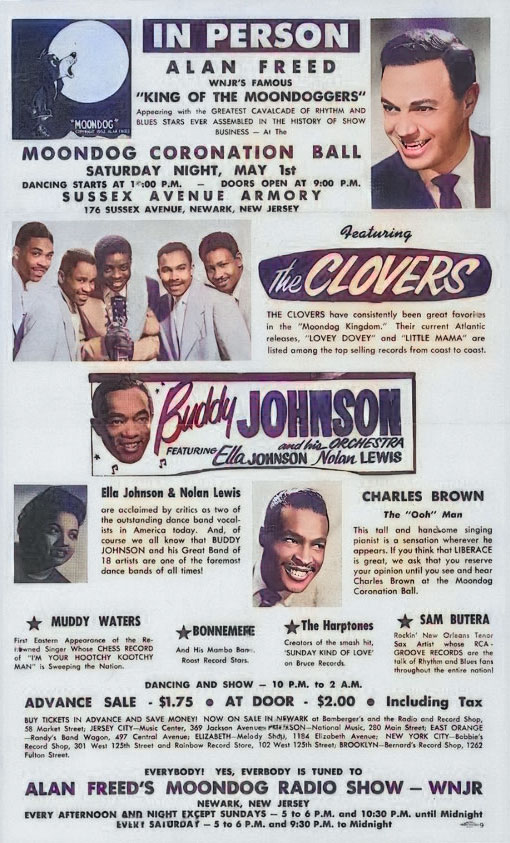
PRESS: NY Deejays Spin Faster Than Disks
Billboard: May 12, 1958
“The disk jockey scene here is in a state of flux...”
Interesting article about the turnover of DJs, including Alan Freed, in NYC. Also announces the move of Scott Muni to WMCA beginning May 26, 1958.
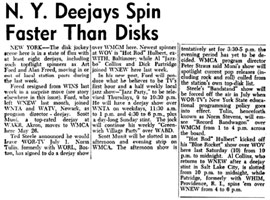
PROMOTION: Dr. Jive Concert
May 30, 1958
“Sit back and relax and enjoy the wax / From three-oh-five to five-three-oh, it's the Dr. Jive show”
Early R&B in Harlem. Dr. Jive was Tommy Smalls who started his career on WSAV in Savannah in 1947 and moved to WWRL in 1952 and he purchased what became the Smalls Paradise Club in Harlem in 1955. He was caught up in the same payola scandal as Alan Freed, but he later worked for Polydor Records in New York and was a founding member of NATRA.
Note: There's a slight chance that this is from 1952, not 1958
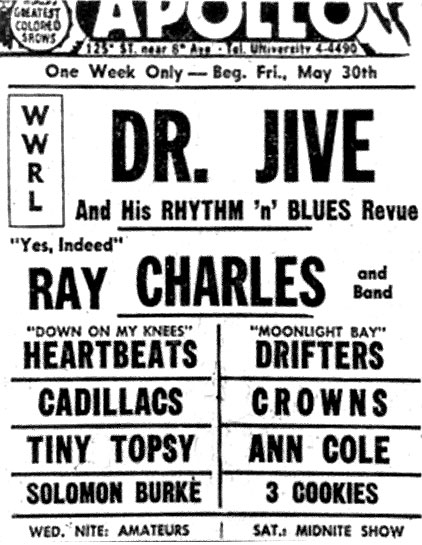
PRESS: “The Beatles Invade, Complete With Long Hair and Screaming Fans”
New York Times: February 8, 1964
Reporter: “Will you sing for us?” Lennon: “We need money first.”
The Beatles invaded America on February 7, 1964 and the NY Times reported on it the very next day. The Times, still a very staid newspaper in 1964 probably didn't know how to handle these invaders - who looked, sounded and acted like no pop stars had ever before.
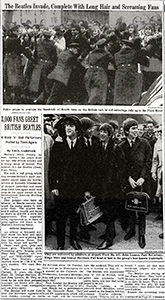
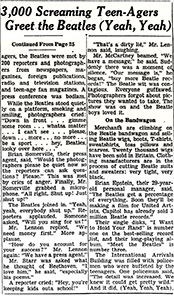
PRESS: The New Sound by Renata Adler
The New Yorker: February 20, 1965
“....he may be greeted by astral screams of "Swing, Charlie, swing!," "All the way with HOA!," "More music and much more excitement, here at Dayton Place!," "Bobaloo, the big fat Daddy Poo!," or "Cousin Brucie! Cousin Brucie! Cousin Brucie! Cousin Brucie! Cousin Brucie!" There may also be voices - apparently submerged in several feet of water - gurgling "Your music authority,seventy-seven, WABeatleC!," and conversation thereafter always proceeds at fever pitch.....”
This great piece by Renata Adler, published of all places in the elite New Yorker magazine in 1965, is one I had never seen before until Chris Ingram posted it on the New York Radio Message Board in early 2016. It's a great analysis of top-40 radio - both the radio stations and the records - just before rock music began to mature. Rock music on commercial FM radio was still 16 months away, we were still a month away from Dylan's "Bringing It All Back Home" LP, which included "Subterranean Homesick Blues", "Maggie's Farm" and "It's All Over Now Baby Blue" and four months away from the Beatles releasing more sophisticated songs on "Help", such as "You've Got To Hide Your Love Away", "It's Only Love" and "I've Just Seen a Face" (although the latter two did not appear on the U.S. release).
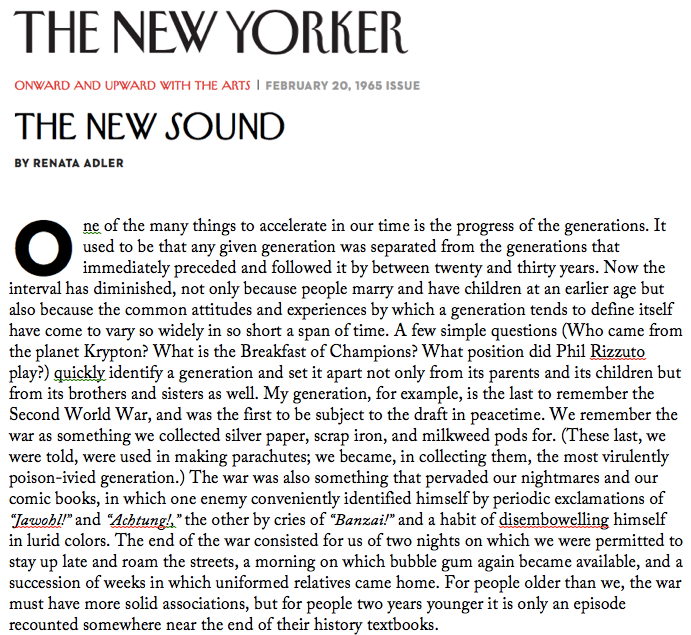
PRESS: “Rocking--and Rolling--With a Message'”
New York Times: June 6, 1965
“The most improbable show of the year so far....”
An announcement of the upcoming Murray the K TV special. It would become very controversial. More below.
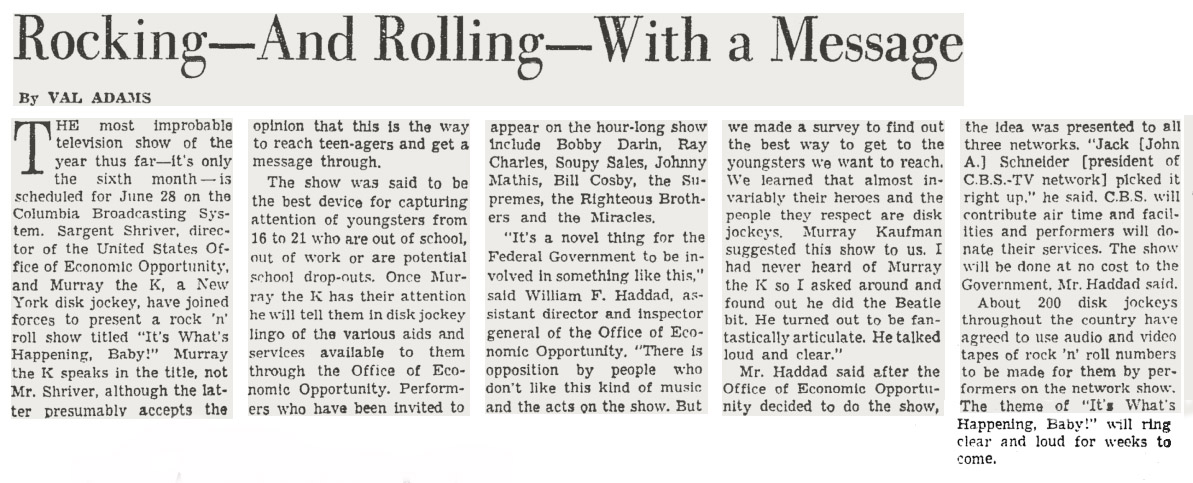
PRESS: Murray the K: It's What's Happening, Baby!
New York Times: June 27, 1965
CBS-TV
“For God sake Murray, you can't have everything.”
This article describes a CBS special that Murray produced for Sargent Shriver's Office of Economic Opportunity to try and get kids to stay in school and to provide some summer jobs for them. It was taped at the Brooklyn Fox Theatre on the day of the math Regent's exam in 1965.
The special was quite controversial: Congress got involved trying to find out why the taxpayers were paying for TV shows about rock and roll. The irony is that since the show was taped on the day of the math Regents exam, all the kids attending the show had either already dropped out of high school, or were in high school, but not in an academic diploma program.
I was on my way to take the math Regents exam when I witnessed Murray taping a scene in front of the Fox theatre, where he comes out of the subway station and into the theatre. Murray used this device often in his shows where this would be projected onto to the screen as the show opened and then Murray would enter the theatre from the rear in sync with the projection. (I saw the same device used a few years later at the Fillmore East for the Voices of East Harlem.) Murray was not in a good mood during the taping of this bit, so the mood described in this article sounds quite accurate.
The Ronnettes were a hit group by this time, having released "Be My Baby" in 1963, but before they started recording, they did a stint as "Murray the K's Dancing Girls". Look at those hero sandwiches they're carrying. They look amazingly good! Wish they made them like that today. And a few doors up the block, there's a sign that says, "homemade Italian ices"! Watching the TV show, I think it's Mott Street.
WOR-FM would launch almost exactly one year to the day of this broadcast and Murray would join the station about three months after that.
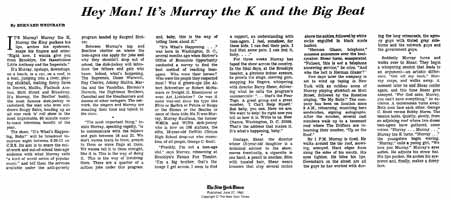
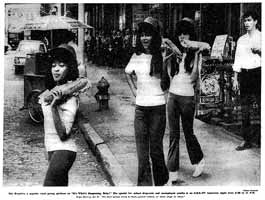
PRESS: Communicating with the Dropout
New York Times: June 29, 1965
“90 minutes of relentless rhythm rendered by a multitude of vocalists who can only be separated from another only by the initiated.”
A review of the Murray the K special. Jack Gould was the NYT TV and radio critic, but he hated rock and he hated Murray the K.
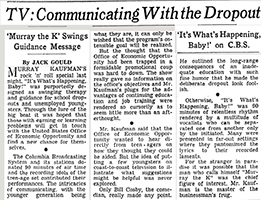
PRESS: Dropout TV Show Irks Republicans
New York Times: June 30, 1965
“I told the president of the broadcasting company, 'I am about to throw up.'”
Republicans in Congress didn't appreciate Murray the K and his rock music TV show special described above very much. But they wanted a "special showing of the film". Meanwhile 16 million people watched the show. Only "Sunday Night Football", "The Blacklist" and "The Walking Dead" get anywhere near that kind of rating today.
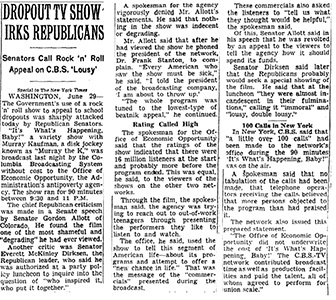
PRESS: "Murray the K Continues"
New York Times: August 1, 1965
Another Murray the K TV special. We don't remember this one.
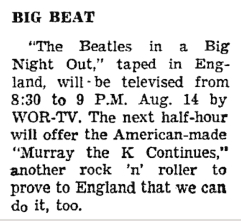
VIDEO: Murray the K with Dick Clark on American Bandstand
December 18, 1965
After Murray the K left wins and before he'd show up on WOR-FM 10 months later, he appeared with Dick Clark on American Bandstand in this YouTube posted video by "YouCanDanceTo It!"
PRESS: Murray the K on TV
New York Times: February 2, 1966
Even another Murray the K TV special. We don't remember this one either.
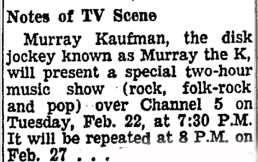
PRESS: The Brooklyn Fox Closes
New York Times: February 3, 1966
Fabian's Fox Theatre on Flatbush Avenue in Brooklyn was the venue for most of Murray the K's Holiday Spectacular live shows. Murray took over these shows from Allan Freed, who held them a few blocks away at the Brooklyn Paramount before Long Island University took over the venue and used the theatre as a gymnasium.
The article states that while the theatre was going dark for movies, it would reopen on April 8th for a Murray the K Holiday show. That was probably the last Murray the K show held at the theatre.
The Fox had over 4000 seats. The Murray the K shows were continuous, usually from 10am until after midnight, although they'd play an incredibly awful movie inbetween each live show in an attempt to get you to leave. But there were probably 7 shows per day, which means they were selling something like 21,000 tickets a day, if you figure 75% of the seats were sold for each performance.
At one time, there were 139 theatres in the U.S. with more than 2800 seats. 29 of those theatres were in NYC.
The Fox was torn down and replaced by an incredibly ugly Con Edison office building which is still standing. LIU has built a new gymnastics facility and the Brooklyn Paramount is planning to reopen as a concert venue. It was originally scheduled for 2018, but it's still not complete and now expected to open in 2024 or 2025.
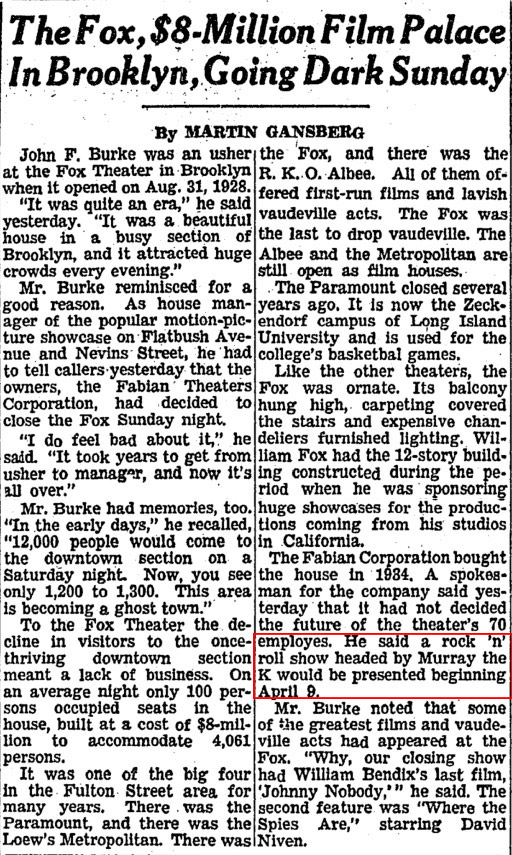
PRESS: “The Murray the K Special for the Year 2000”
New York Times: May 18th, 1966
An announcement of another Murray the K TV special. The Times didn't seem to like this one either.

PRESS: “Ruling on AM-FM Duplication May Be Boon to Music Lovers”
New York Times: June 8th, 1966
An article detailing how the new FCC rule requiring stations in cities of more than 100,000 people to not simulcast the AM signal on FM more than 50% of the time will probably result in more diverse music on FM. Note that aside from a mention of "The Young Sound" on CBS-FM, they had no inkling as to the future penetration of rock music on FM.
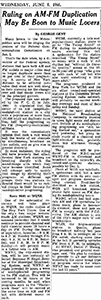
FM Guide Listings
August 1966
This is the first in a series of listings from FM Guide. FM Guide divided their listings into daily listings, presumably for schedules that varied from day-to-day and standard listings, where shows didn't vary from day-to-day, although some stations wound up in the daily listings that didn't need to be there.
FM Guide was quite useful if you were a classical music fan and wanted to know when a particular composition was going to be broadcast, but it wasn't very useful for rock stations.
FM Guide needed a 2-3 month lead time to change the listings, so it was almost always out-of-date. But we still loved it at the time because we were desperate for any news about FM.
This issue is from August of 1966, just after WOR-FM changed to a rock format, but before the jocks appeared on the air.
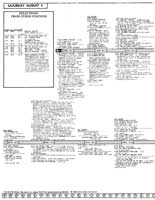
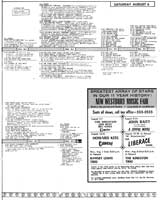
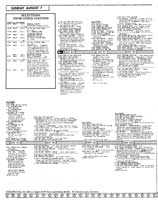
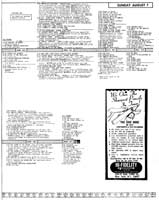
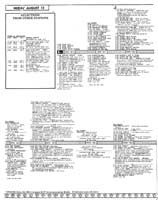
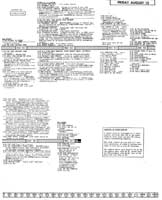
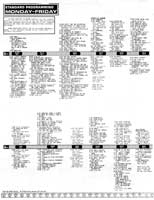
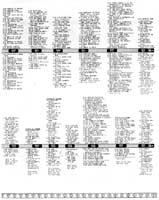
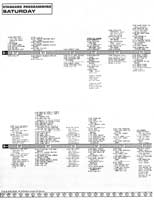
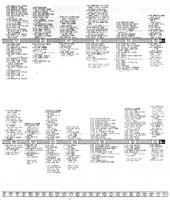
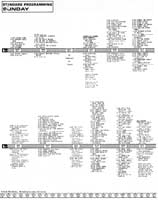
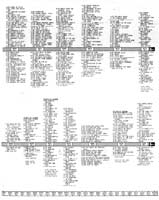
PRESS: FM Ratings
Broadcasting Magazine: July 31, 1967
Ratings from July of 1967. WOR-FM was at the tail end of the progressive rock format and WNEW-FM had the "all-girls" MOR format.
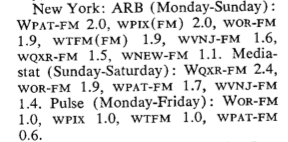
TV Show: Coronet Blue: The Flip Side of Timmy Devon
Broadcast Septembrer 4, 1967
This was an episode of a TV series that I've never heard of and might have been broadcast on CBS. It was supposedly filmed in 1965, but not broadcast until 1967, which means it was probably produced right after Murray left 1010 WINS. This episode features both Murray the K (as "Bit Hart") and Dick Clark (as "Victor Brunswick") and also features Sally Kellerman (late of M*A*S*H* fame).
PROMOTION: Murray the K's WPIX Special
Broadcasting Magazine: circa September 22, 1967
WPIX TV
“All That's Swinging, Daring, Alive”
A black and white promotion for the color Murray the K special, "The Sound Is Now!" described below.
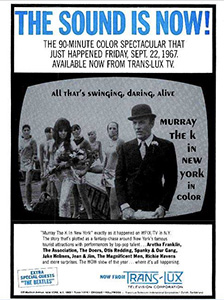
PRESS: Murray the K WPIX Special Review
New York Times: September 23, 1967
WPIX TV
“Murray the K was relentless on the screen...”
A review of a special that included Aretha Franklin, the Doors, Richie Havens and the Association. This review by Jack Gould was pretty negative. But he didn't like FM radio and he liked rock even less. He was probably not the right person to write the review.
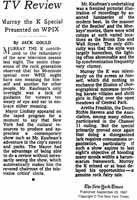
PRESS: Dominic Sicilia's Progressive Rock Show
Billboard: January 13, 1968
There were lots of experiments with playing rock on FM that are little remembered today. One of them was Dominic Sicilia's show on WHBI.
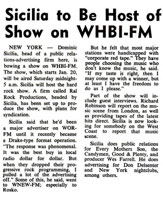
SURVEY: WWRL Hot 16
January 29, 1968
WWRL 1600
A great list of tracks, including those that have become part of the canon and some more obscure with Frankie Crocker holding down the night shift. He would later move to WMCA.
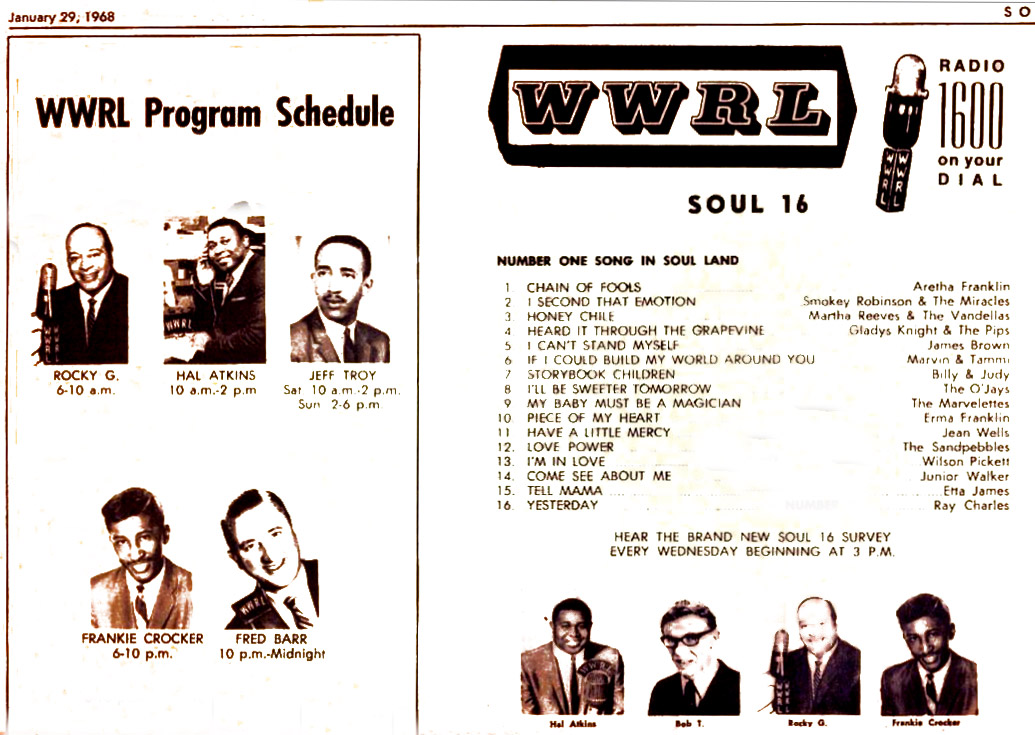
PRESS: 1st FM Rock
FM-Guide: April, 1968
WFUV-FM
FM Guide noting that Pete Fornatale had the first regularly scheduled rock show on FM
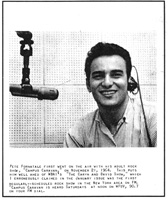
and Pete Fornatale in 2009...

PRESS: KSAN-FM Goes Freeform
Billboard: May 25, 1968
Metromedia's KSAN in San Francisco picks up Tom Donahue and team, formerly of pioneer progressive rock station KMPX-FM.
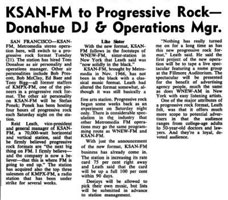
PRESS: Hip Rock Radio Busting Out Across U.S.
Billboard: July 6, 1968
“We receive more letters from listeners of our present format than in all the years of our old middle-of-the-road format.”
Two years after WOR-FM launched and nine months after WNEW-FM launched its rock format, progressive rock was finally quickly spreading across the country.
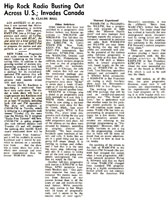
PRESS: Classical Music Played on Rock Stations
Billboard: July 20, 1968
A Billboard article noting that FM jocks sometimes played classical music on their rock shows.
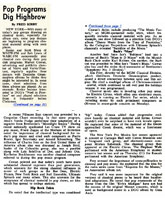
PRESS: Growth of Progressive Rock Across U.S.
Billboard: Oct 19, 1968
An article detailing the growth of progressive rock radio across the U.S., especially WNEW-FM and KSAN-FM.
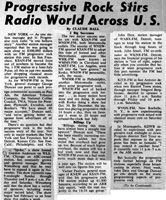
PRESS: FM Program Index
FM Guide: November, 1968
A genre-based program index from the pages of FM Guide. Note the diversity of programming on the FM Band in 1968.
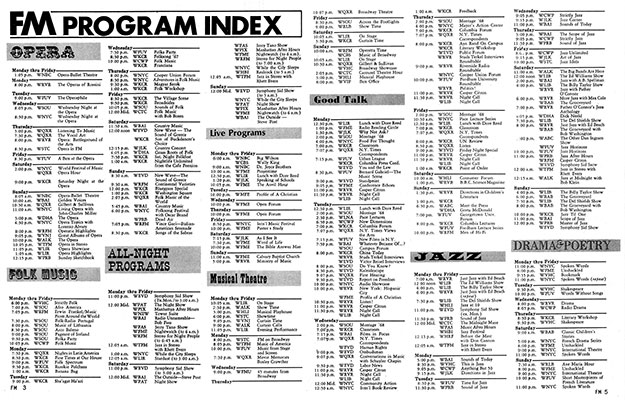
PRESS: 1969 FM Ratings
FM-Guide
Arbitron Ratings for April-May 1969
FM Ratings - note that Drake formatted WOR-FM is trouncing everyone
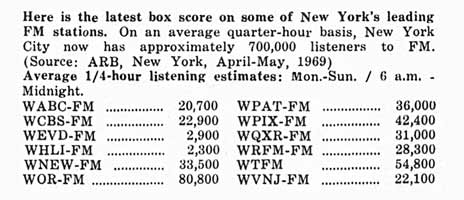
PRESS: The Underground Radio Turn-On
LOOK Magazine: June 24, 1969
An article about the "new" underground radio. WNEW-FM, KSAN and KMPX are mentioned.
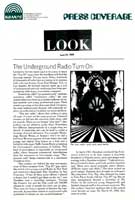
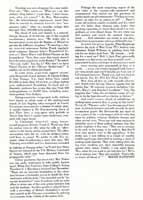
PRESS: NY Metropolitan Area FM Station List
FM Guide: April, 1970
A list of the area radio stations and their locations.
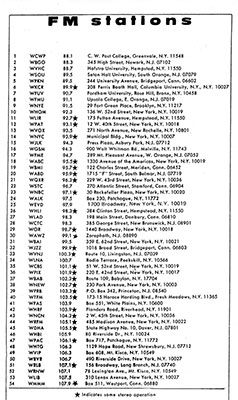
PRESS: The Maynard Report
FM Guide: April, 1970
“WOR-FM is now seventh among all radio stations, and first among FM stations; WNEW-FM is twelth among all radio stations, and third among FM stations; WPAT-FM is fourteenth among all radio stations, and fourth among FM stations.”
This is a one-page report published in FM Guide magazine. Maynard got some things right and some things wrong. He asked if AM was to become a no-music, all talk medium and he got that right. But he also thought that Quad broadcasting (four-channel stereo) would be successful and it wasn't. Also, I'm not sure that WNYC-FM was the first to broadcast in Quad, I think that credit belonged to WQIV 104.3.
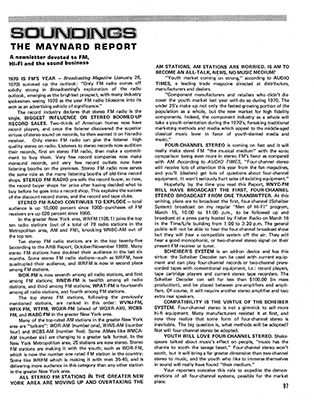
PRESS: FM Radio...Maker of Record Sales and Stars
FM Guide: May, 1970
“It is my contention tht the record industry, haivng recognized what an impact stereo FM radio had on the buying public, changed its direction. The record industry has enlarged its recording perspective and embraced progressive rock.”
In the 1970s, WNYC-FM broadcast a program on Sunday nights called "Men of HiFi". The program addressed current and historical topics about both the technology and business of broadcasting.
FM Guide would frequently publish edited transcripts of those shows. This one is about FM's evolving rock radio formats and their impact on record sales. It featured Claude Hall, who was Radio and TV editor of Billboard magazine; Jack Maher, an advertising manager for RCA records; and Nat Asch, GM of KMET-FM and formerly PD of WNEW-FM. It was hosted by Harry E. Maynard.
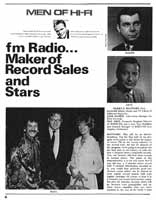
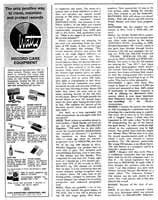
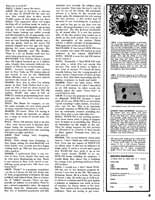
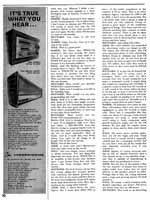
TIPSHEET: Walrus
June 24, 1970
“There are some things of particular interest. 'Impromptu in E Minor' employs a male chorus that sounds like early Christian chanting which adds to the drone effect...”
While top-40 stations could rely upon Billboard and other trades or their surveys of local record stores, progressive rock stations had a harder time deciding what to play. In this era, many stations still permitted air personalities to pick most, if not all of their own music, but many music directors needed additional help to decide if they were playing the "right" tracks. Tip Sheets, which were simply lists of tracks either recommended by the "consultant" or played by other radio stations, served that purpose.
Many of the creators of these services later became radio consultants.
I wonder how many radio stations started playing the Mae West album on the basis of this recommendation. How many of these tracks/albums do we remember today? And note that WABC-FM participated, but WNEW-FM did not.
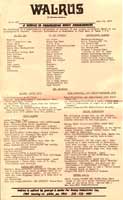
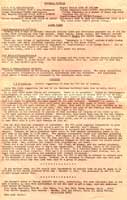

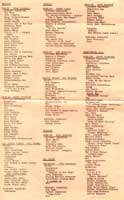
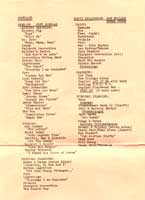
PRESS: Dissidents Take Over FM Rock Station
Broadcasting - Nov 30, 1970
“...the station became "violently radical." Its music went beyond rock to include avant-garde jazz, African music and other sounds calculated to attract a multinational "free community" audience...”
With the exception of listener-supported WBAI and possibly WFMU, radicals never really gained any positions of power in New York FM stations. But on the west coast, they did. But what I really love about this article is the quote above.
Hmm...'can't have any of that radical avant-garde jazz stuff -- people who listen to that might get violent -- and we don't want any hyphenated-Americans listening to our station. What will that lead to?' Having said that, the people who attempted to take over the station were probably power-hungry fools themselves. But I wasn't there, so perhaps it's unfair to make that evaluation.
What does this have to do with New York radio? Events like this scared broadcasters across the country (as well as the FCC) and it probably helped lead to more control, more management, the hiring of consultants and the start of a decline in the power of the air personality, which culminated at the end of the 80's, when air personalities lost most control over their programming.
The funny thing about all this in retrospect is that rap and hip-hop became far more radical than avant-garde jazz and African music, yet rap and its offshoots were embraced by the corporations who had taken over radio after deregulation. They realized that in the pursuit of bonus money and shareholder value that politics no longer mattered (and they didn't understand the politics anyway) -- if it made money, they were for it.

WLIR Footage
circa 1971
Contributed by Highnote on YouTube
Some silent 8mm footage of WLIR, circa 1971. This video stars Joel Moss as the diner-fries eating hero (his career was all radio broadcasting) and Steve Straubing (later Dr. Steve Straubing now a retired MD).
ADS: American Top-40
Broadcasting - March 8, 1971
Syndicated radio specials really started to take hold in the 1970s. FM Progressive rock stations went with things like the King Biscuit Flower Hour, a live concert show. Top-40 stations went with American Top-40, a countdown show originally hosted by Casey Kasem. I always failed to see the appeal of these countdown shows, since they could be produced locally fairly easily, aside from the fact that it was usually free programming.
Here are two trade ads from AT40 from Broadcasting Magazine in 1971.
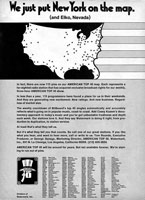
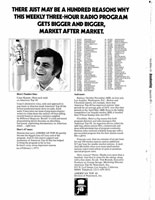
HISTORY: WPIX-FM goes Top-40
Circa 1971
WPIX-FM (currently WFAN-FM) has had a long history with numerous formats. The station was first owned by William G. Finch and went on the air as WGHF in 1947. In 1948, it became the NYC affiliate of the Rural Radio Network. In 1955 it was sold to Muzak and became WBFM. Around 1964, it was sold to the New York Daily News and it became WPIX-FM and adopted the "Pix Penthouse" Easy Listening format, which did quite well for an FM station in the era before most people started listening to FM. The "PIX" was a reference to the Daily News' branding as "New York's Picture Newspaper". In fact, in May of 1965, over a year before the advent of rock WOR-FM, WPIX-FM managed to be the 10th most listened to radio station in New York when all nine stations above it were AM stations.
From 1971 to 1975, it tried an "Adult Top-40" format, switching to Disco for about a year before returning to an adult top-40 in 1976 and 1977. In 1977 and '78, it shifted the emphasis to rock and from 1978 to 1980, it became a "Punk/New Wave" station, although it also included other music and oldies. It promoted itself as "From Elvis to Elvis", referencing Elvis Presley and Elvis Costello. And Meg Griffin, for one, was still playing largely free-form and progressive rock on weekends.
It became a full-fledged AOR station in July of 1981, but in January of 1982 tried top-40 again and then returned to Adult Contemporary music. By 1983, that became "Nothing But Love Songs", which comprised of slightly downtempo adult contemporary music. In 1985 that became "Hot AC" with the theme "The Ballads and Beat of New York". By late 1985, that became "Your X Wants You Back", which was once again an adult contemporary format, but without the love songs. In late summer of 1986, that switched to a mix of adult contemporary and standards in an eclectic format marketed as "The Bright and Lively Sound of New York". In 1987, they tried "Hot AC" during the day, but contemporary Jazz at night. In August of 1988, they stunted with a format that mixed Jazz, New Age, soft rock and soft soul, playing 60% instrumentals and keeping soft Jazz at night. But at the end of August it became WQCD Soft Jazz playing contemporary jazz with just two vocal tracks per hour. By 1990 that evolved to both soft jazz and soft AC and they started playing some soft urban and soft rock. At this point, they played about 1/3rd vocals.
In 1997, the station was sold to Emmis Broadcasting, but they continued the format. But in November of 2004 they tried a format called "Chill" which was jazz oriented music associated with the beaches and the tropics. In August of 2005, they returned to a soft jazz format that also combined recent soft adult contemporary songs from the '80's onwards.
On February 5, 2008, the station became WRXP, the "New York Rox Expeience" with an "adult album alternative" format. That lasted until July of 2011, when the station was purchased by Merlin Media, changed its call letters to WEMP and stunted with a return to adult contemporary music before becoming the first FM station with an all-news format on August 12th. But that format was poorly executed and an attempt at automation was a disaster. So on July 17, 2012, the station returned to an alternative rock format branded as "New Rock for New York" and a week later, changed the call letters back to WRXP. But Merlin Media had huge debt and they sold the station to CBS Radio less than three months later. CBS turned the station into WFAN-FM, simulcasting the AM sports station.
In 2017, CBS announced it was spinning-off its radio operation to Entercom Broadcasting.
PRESS: The State of Radio 1971
Broadcasting - June 21, 1971
“Billy James Hargis was one of my inspirations for this kind of radio...he was playing Phil Ochs and Dylan and Joan Baez. And after every number he would get on and say 'Did you hear what that commie said?' But in the process he was also putting on some music no one else was playing. It was a hell of a show.” -- Tom Donahue
A special report detailing the state of radio in 1971 with a special emphasis on FM rock radio with comments from Les Turpin (CBS-FM), Tom Donahue (KMPX) and Bill Drake.
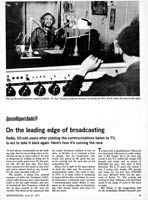
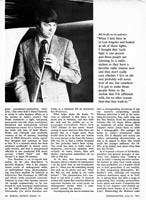
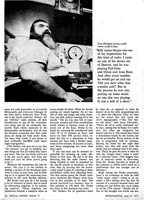
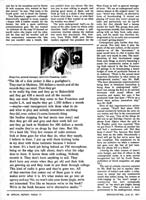

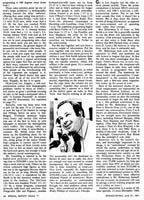
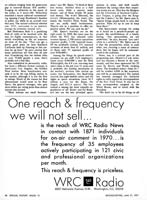
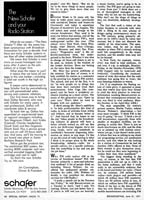
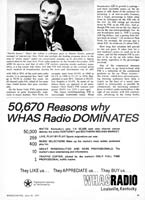

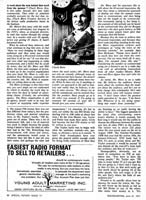
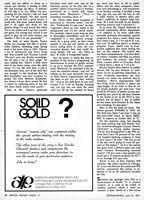
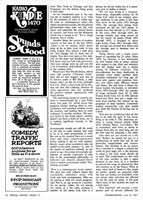
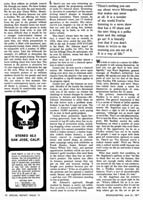
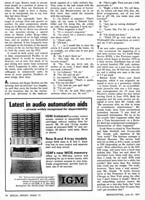
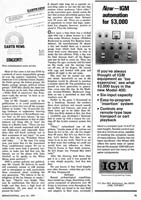
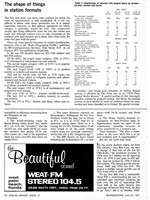
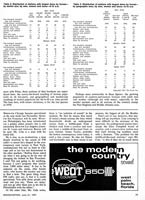
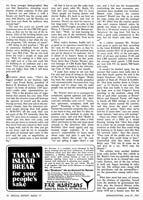
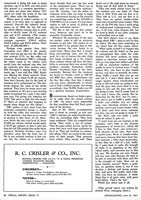
PRESS: Another Scare Thrown Into Undergound Radio
Broadcasting - Aug. 23, 1971
“Mr. Westen, for one, feels that the commission has spelled out 'the end of free-form underground stations'”
An article detailing potential FCC interference in free-form radio stations.
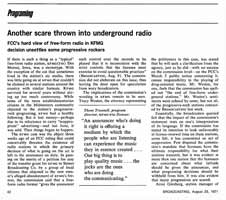
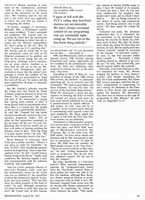
PRESS: Here Come the Automaters
Broadcasting - Aug. 23, 1971
“We try to project a single emotion--love”
An article detailing three approaches to automated music on FM.
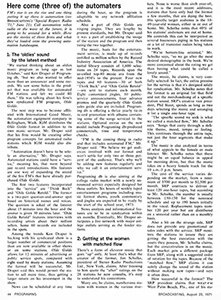
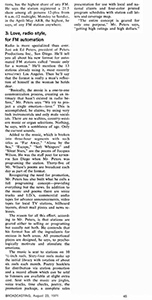
JOURNALISM: "Pop Scene" by Al Aronowitz
New York Post - September-October, 1971
“But they don't break records in New York any more, not on Top 40 radio, and certainly not like they did when they had Scott Muni oon WABC, B. Mitchell Reed on WMCA and Murray the K on WINS”
Back in the days before Murdoch bought the New York Post, the Post was an afternoon liberal newspaper that was very strong in entertainment coverage. Al Aronowitz was a columnist for the Post and covered music, radio and the media. These sample columns cover Beatles John and Paul, radio and Murray the K.

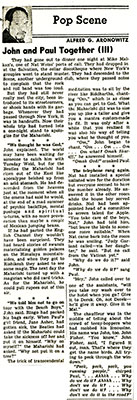
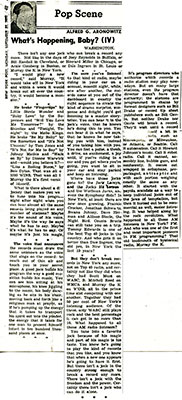
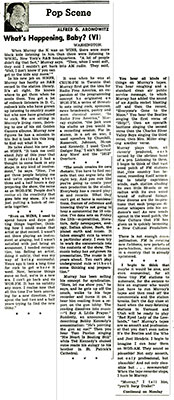
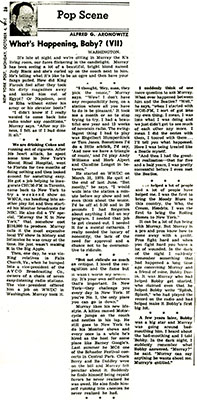
PRESS: 1971 Music & Radio
Broadcasting - Dec. 27, 1971
“Between 1964 and 1966, the years of the British invasion of the U.S. music industry, record sales jumped 34%.”
An article detailing the relationship between 1970s music and pop radio.
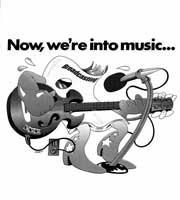
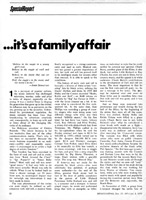
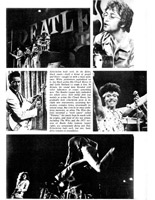
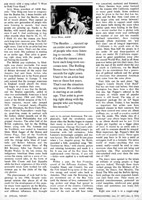
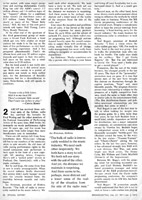
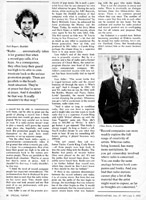

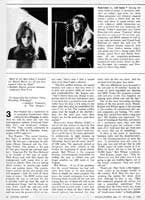
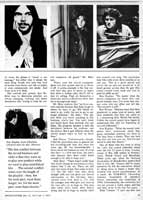
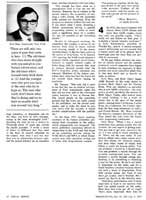

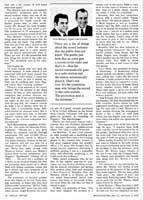
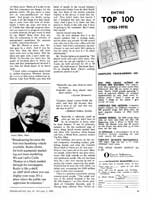
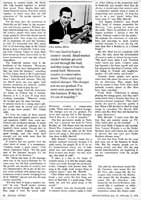
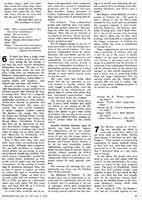
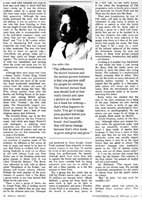
PRESS: Live Music Revival Wins Radio Fans
Broadcasting - Jan 10, 1972
“WNEW-FM had two special holiday broadcasts, a presentation of Leonard Bernstein's "Mass," and a taped concert of Led Zeppelin, obtained from the BBC.”
Back in 1972, progressive rock stations were still brave enough to take a risk and broadcast a live concert, frequently from a single act. As the article states, WNEW-FM claimed three million listeners for a Grateful Dead live concert. They even had the guts to broadcast a winter holiday broadcast of Leonard Bernstein's "Mass". Today we'd be lucky if WQXR took that kind of "risk". There are two views one can take on this. Either you believe that this was bad programming because there was too much of a chance that a listener would tune out if they didn't like the group or didn't hear the hits, or you believe that this was brave and exciting programming.
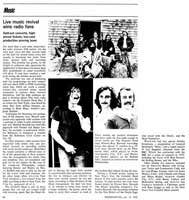
PRESS: Censorship Snag Over Dylan Record
Broadcasting - Jan 10, 1972
“Clearly, Bob Dylan...could publish a book of his songs and if a four-letter word appeared, no one would be alarmed. To say that same song cannot be performed on records is frankly demeaning to the medium.”
An article about the controversial song, George Jackson, by Bob Dylan. Some things never change. The FCC and the courts are still debating this issue. But the word in question is now regularly heard on television after 10pm, so maybe things do change.
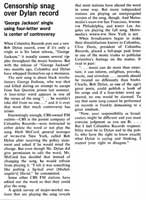
SURVEY: WLIB 1190
February 2-8th, 1972
Contributed by Rich Barbato
Wow! There's some killer music here. I wasn't listening because it was AM, but I wish I could go back in time and spend time with this station.
It's interesting that in addition to the survey itself, they seem to be listing the best sellers of various record distributors, with Malverne, Beta and Skyline covering the independent labels, Alpha covering Motown and Warner-Atlantic covering...well, you know.
Aside from the distributor lists, they've listed 135 records. Wonder if they really played them all. Note the categories for instrumentals, jazz, blues and Latin. This is why people listened to the radio and in spite of the deep libraries of the streaming services, if you seed a few artists, you're not going to hear the range of music represented on this survey.
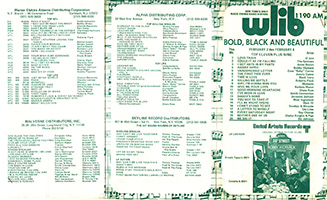

PRESS: The Coming Out of Undergound Radio
Broadcasting - Feb 26, 1972
“...the hybrid format with its less restrictive playlist is slowly making its mark in the mass-oriented conservative world of AM radio.”
An article detailing the move of FM-style progressive rock programming to AM in Los Angeles. An attempt to compete with FM, but did it last?
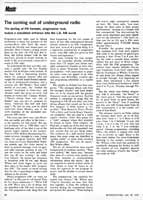
PRESS: Waves Upon the Ether (Pt. I) by Larry Yurdin
Crawdaddy - April 30, 1972
“Donahue combined the kind of free-form style that Bob Fass in New York, Uncle T. on his Freedom Machine in Boston and Peter Bergman on Radio Free Oz in L.A. had been doing on non-commercial radio, with his own pragmatic commercial sense.”
Part 1 of a two-part article analyzing the state of free-form radio from the perspective of Crawdaddy magazine, including sidebars on Alex Bennett, Bob Fass and Tom Donahue.

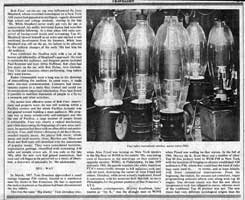
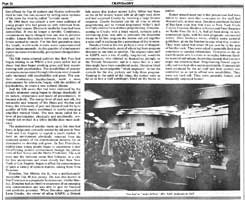
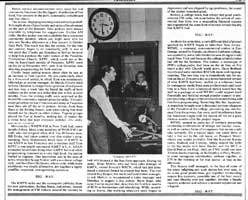
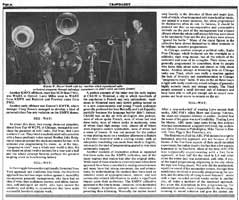
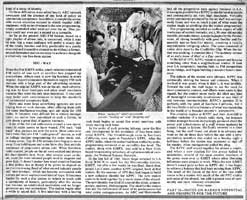
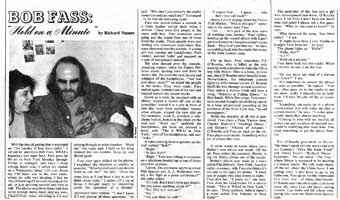
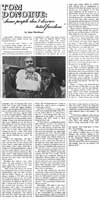
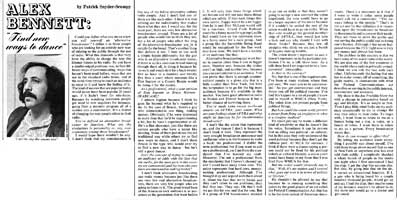
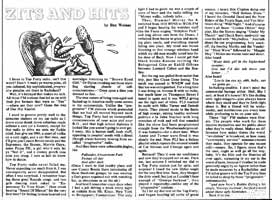
PRESS: Waves Upon the Ether (Pt. II) by Larry Yurdin
Crawdaddy - May 14, 1972
“There's one basic problem with free from radio and that's the total lack of direction”
Part 2 of a two-part article analyzing the state of free-form radio from the perspective of Crawdaddy magazine, including sidebars on Mike Turner and Steven Segal. Turner was part of the ABC-Network freeform experiment and Segal was on the air at KMET in Los Angeles.
While this article is quite interesting, it's also self serving. Yurdin was involved with WABC-FM and he writes negatively about WNEW-FM in general and Rosko in particular as if he was a third-party observer.
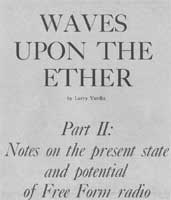
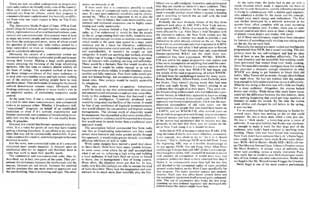
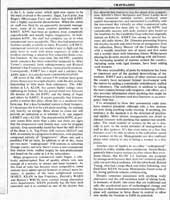
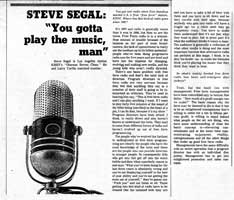
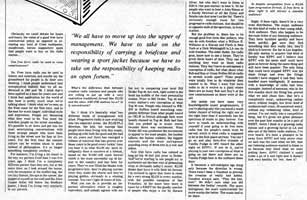
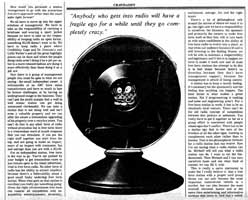
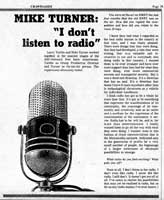
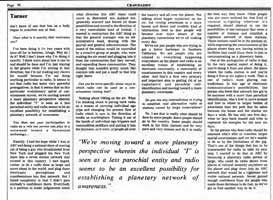
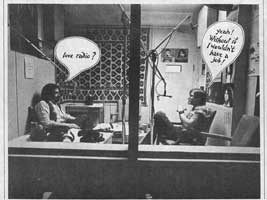
PRESS: Murray the K's Live Show at the Academy of Music
New York Times: Feb 19, 1973
“...workingf on a 1973 variant of one of the rites of puberty, the sick (sic) hop.”
Apparently, Murray decided it was time to return to oldies as this show presented Jay and the Americans, the Drifters, the Shangri-La's, the Ronettes, Sam and Dave, the Impressions and other 50's groups.
I thought the New York Times did a much better copy-editing job in decades past, but this article belies that theory. Note the quote above. The writer probably thought that "the sick hop" made a lot more sense than "the sock hop". And then there's that extra "f".

PRESS: KSAN Ratings
Billboard: Nov 17, 1973
“I would surmise that KSAN-FM is the most successful progressive station in the nation with regards to ratings, though WNEW-FM...might be grossing more dollars.”
An interesting article about progressive KSAN (San Francisco) and how well it did with women listeners.

PRESS: Murray the K leaving WNBC
New York Times: Feb 4, 1974
WNBC
“They want to tell me when to play the Top 30, the Top 10, and when to play a 'gold'" he said after going off the air. That radio is not for me...”
An announcement that Murray would be leaving WNBC. This is one of many stations that Murray did short stints at the final decade of his life. Little did he know that controlling when he played a top 10, top 30 or oldie would be considered to be a massive amount of freedom just a decade later.

PRESS: Murray the K Planning TV Show
New York Times: Feb 15, 1974
“The music is ten years ahead of the way it's presented on the radio...”
Murray always seemed to have another scheme at the ready when leaving a prior position, but not all of them came to fruition. This looks like one that didn't make it.

PROMOTION: WPIX-FM
The National Lampoon - August 1974
Contributed by Myles Putnam
“Non Stop Music Is Everywhere”
The hand-drawing is representative of a time in which FM stations were trying to promote themselves as being hip and local and not corporate.
Interesting that almost all of the businesses depicted are in the Village below 14th street. And it's really kind of sad that almost every one of the businesses shown is long gone - businesses that largely made the Village the Village.
WPIX went through many formats, but this was during its Top-40 era, which included Les Marshak, Dennis Quinn, Jim Horne, Al Gee and Jerry Carroll. Shortly after this, in the Fall, there'd be some slight changes with Ted David taking over mid-days, Carroll moving up to evenings and Alex Hayes taking over nights. The station is obviously promoting the fact that they had little to no advertising.
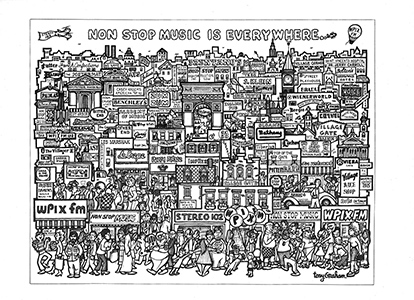
INTERVIEW: Bruce Morrow
March 19, 1975
Source: YouTube - Tight and Bright
An interview with Bruce Morrow recorded just 6 months after he joined WNBC in mid-August of 1974. Bruce started in the evening shift; moved to 10am-2pm from December '74 to March of '76, then back to evenings until August of 1977. Other jocks on the station in that era were Don Imus in mornings, Joe McCoy (later PD of WCBS-FM), Walt Baby Love (formerly of WOR-FM), Dick Summer (WNEW-FM) and Johnny Michaels (WOR-FM). That staff would be fired when Bob Pittman took over the station in the Fall of 1977.
Bruce criticizes many people in this interview including Rick Sklar and Murray the K, but it was Kaufman's arrival that forced Brucie out of WINS. I don't know what Bruce was complaining about - he had a great career by moving to WABC before WINS became a news station.
The only strange thing is that this doesn't actually sound like Bruce Morrow, although he does pick up the phone at one point and says, "This is Bruce Morrow". He sounds pretty ordinary and not like a DJ. Weird.
SURVEY: WPIX-FM "Non Stop Music"
January 22, 1976
Contributed by Rich Barbato
A survey for WPIX FM 102 from 1/22/76. Mostly soft rock in this era: Frankie Avalon, Paul Anka, ELO, Bay City Rollers, John Denver, Neil Sedaka, Elton John, Linda Ronstadt. Someone there must have liked the 1950s.
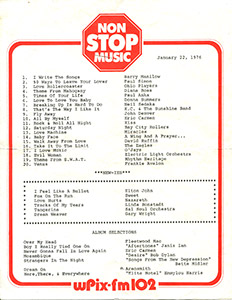
AD: WPIX-FM Jim Kerr
Village Voice: October 17, 1977
An ad for the great Jim Kerr back when radio stations still did newspaper promotions.
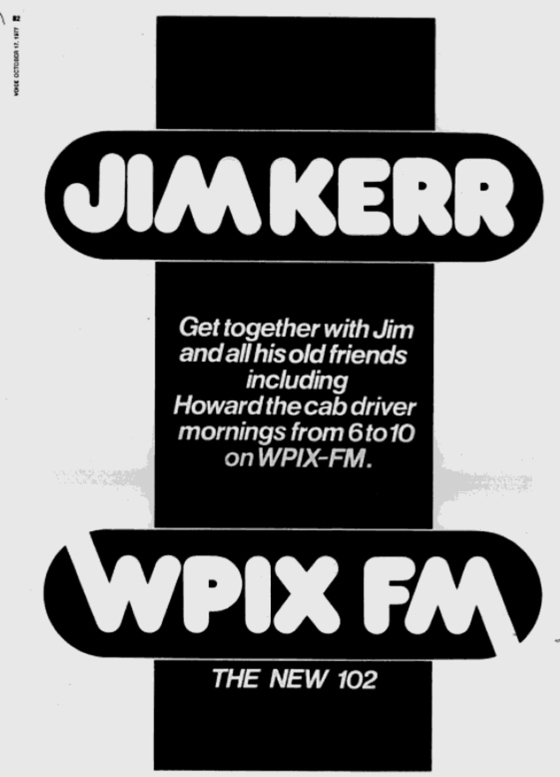
New York Radio Guide Listings
Radio Guide - July, 1978
Program listings from Radio Guide, a short-lived publication about AM and FM radio in New York.
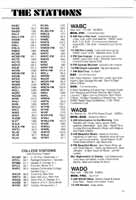
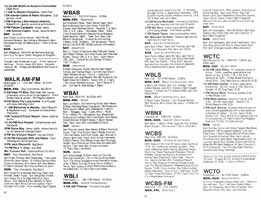
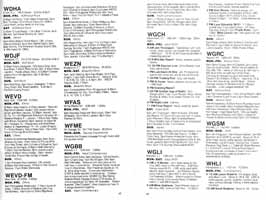
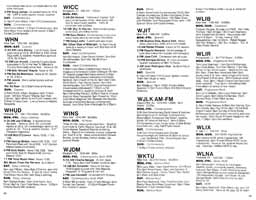
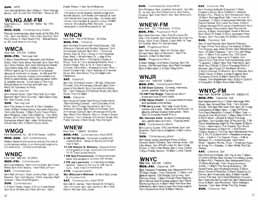
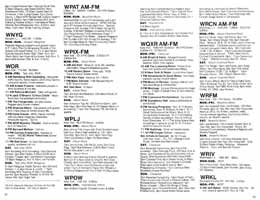
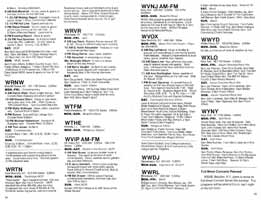
PRESS: Women In Radio
Radio Guide - July, 1978
“At last count, New York Radio stations employed 11 female deejays and five female station managers...”
An article from Radio Guide featuring Alison Steele, Carol Miller, Vivian Rountree and other fem DJs.
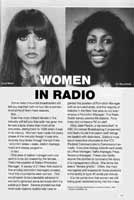
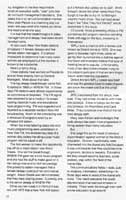
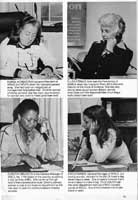
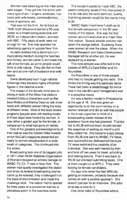

New York DJs
circa 1979
We don't know much about this. The file was sitting in our "to do" folder with no indication of where we got it from. It appears to be from a newspaper, but we can't tell which one, although I'm guessing it might have come from the NY Daily News. But it's a great review of all the radio air personalities of the time, which we're also guessing is 1979.
(Click for a larger version).
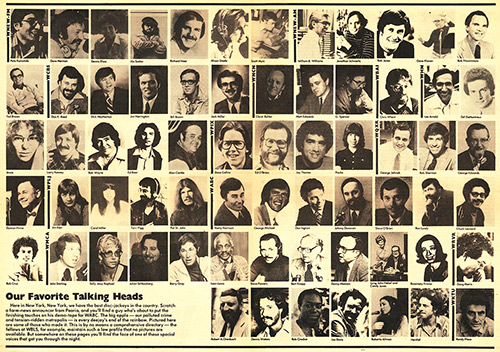
PRESS: NY Times: Ratings for NYC Radio Stations
December 25, 1979
Disco takes over the world. WNEW-FM, while still at the top of its creative form, only has a measly 2.7% of the audience, although one could argue that WNEW-FM listeners were highly unlikely to participate in surveys.
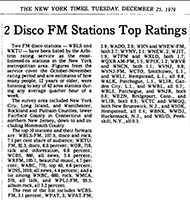
PROMOTION: WFMU Poster
cica early 80's
Contributed by David DiSanzo
WFMU was originally a college station operated by Upsala College in East Orange, New Jersey, but there were reportedly battles between the school and the staff over the programming and by the 1980's it pretty much operated independenty. Upsala went into bankruptcy in 1995 and a group of people associated with the station formed Auricle Communications and bought the license from the school. Vin Scelsa was an air personality there beginning in 1967, before joining WLIR and WBAI and eventually winding up at WABC-FM and later, WNEW-FM, Sirius Satellite Radio and WFUV.
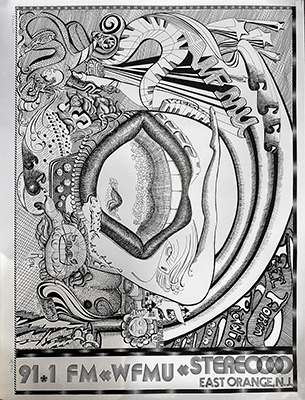
AIRCHECK: NYC Radio Sweep about John Lennon's Death
Monday, Dec 8, 1980 (44:56)
contributed by Anthony Russo on YouTube
A radio sweep the night that John Lennon was murdered.
SURVEY: WYNY Top 97 of 1983 and 1984
circa 1985
Lionel Ritchie and the Police at the top of each year.
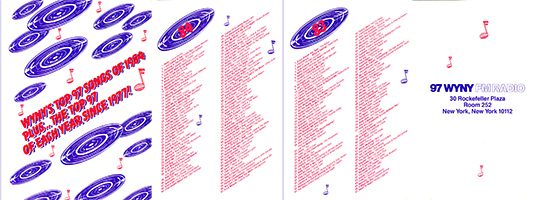
SURVEY: WHTZ Z100 Year-End Top Albums 1985
Contributed by Rich Barbato
Bruce, Madonna, Sting, Dire Straits, Prince, DeBarge, Motley Cure, McCartney. Nothing wrong with all that. But how deep did they go?
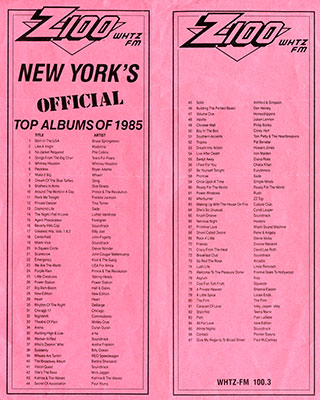
SURVEY: WBLI 106 April 12, 1986
Contributed by Rich Barbato
Well at least they played the Stones cover of the Harlem Shuffle
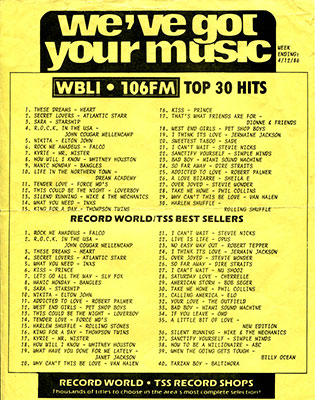
SURVEY: WHTZ Z100 April 28, 1986
Contributed by Rich Barbato
Dirty Work on a Manic Monday
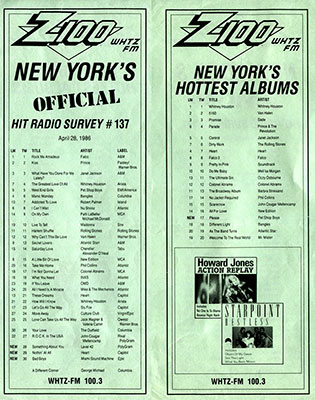
SURVEY: WHTZ Z100 May 12, 1986
Contributed by Rich Barbato
Bad Boys are Addicted to Love
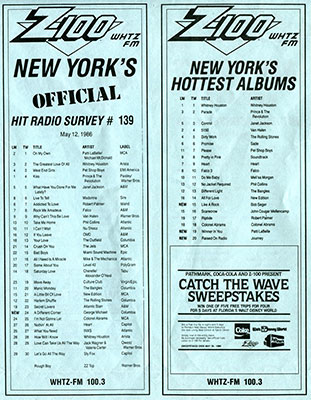
PRESS: Oldies on Rise in Album-Rock Radio
NY Times: June 15, 1986
“In New York City, the highest-rated album-rock station, WNEW-FM (102.7), plays older rock approximately 60 percent of the time...”
Jon Pareles writes about the rise of oldies on AOR radio throughout the country. This was necessary because older audiences were getting turned off to much of late 1980's music, but it backfired when listerers got so tired of hearing the same tracks, they started to abandon radio. WNEW-FM reacted by changing to an alternative format, but that performed even worse.
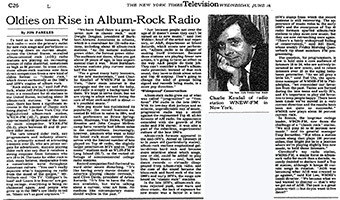
SURVEY: WHTZ Z100 December 22, 1986
Contributed by Rich Barbato
Everybody have Wang Chung tonight
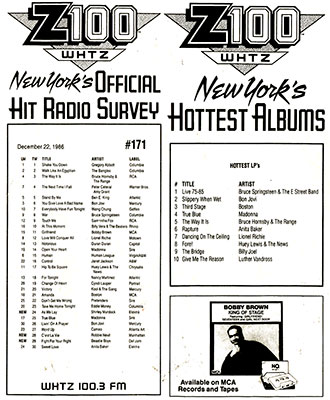
SURVEY: WBAB Year-End Album SURVEY 1986
Contributed by Rich Barbato
A pretty diverse list of albums from WBAB, Babylon 102.3
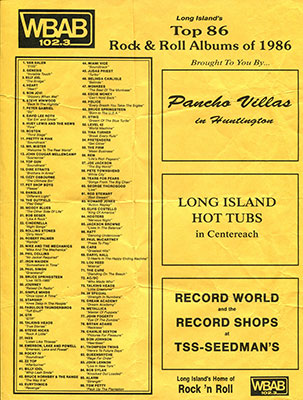
SURVEY: WHTZ Z100 January 26, 1987
Contributed by Rich Barbato
War
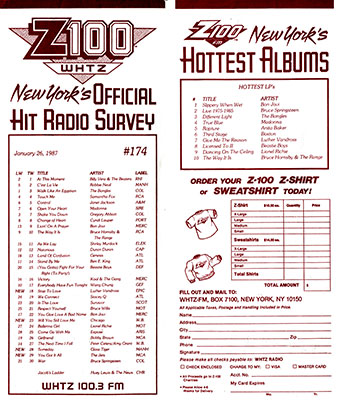
SURVEY: WHTZ Z100 March 16, 1987
WHTZ Z100, at 100.3 and currently owned by iHeart Media, is the only NYC top ten radio station to have pretty much maintained its billings over the years. It billed $49.4 million in 2000 and $48 million in 2016. Here's a survey from March 16, 1987.
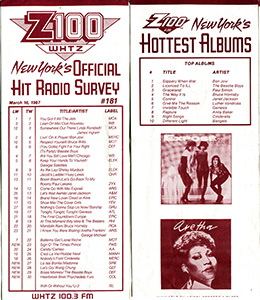
SURVEY: WHTZ Z100 January 11, 1988
Contributed by Rich Barbato
Tiffany and Tiffany
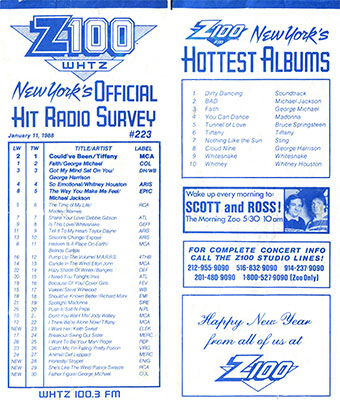
SURVEY: WHTZ Z100 July 18, 1988
Contributed by Rich Barbato
"I Don't Want To..." Pick one: "Go On With You", "Live Without Your Love"
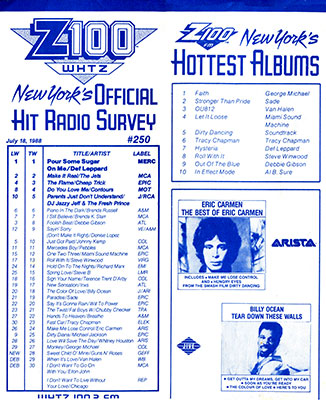
SURVEY: WHTZ Z100 August 1, 1988
Contributed by Rich Barbato
Chubby Checker back on the charts
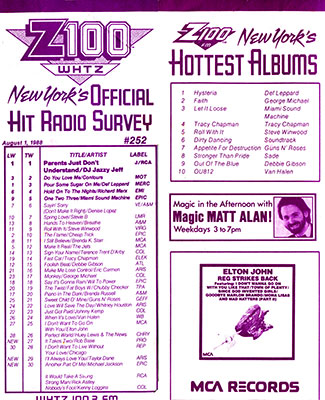
SURVEY: WHTZ Z100 November 14, 21, 1988
Contributed by Rich Barbato
The Beach Boys hit again
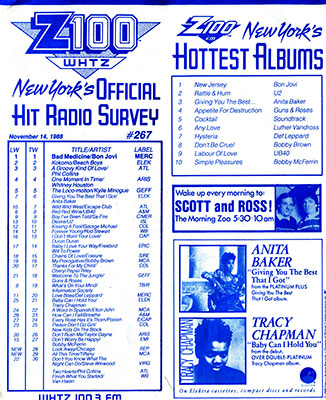
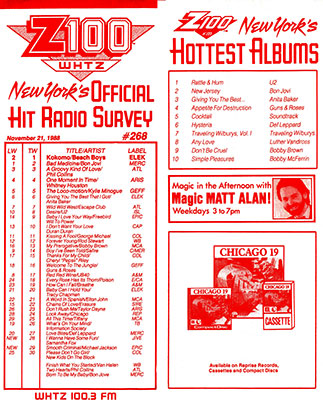
SURVEY & SCHEDULE: WQHT HOT 97 November 20, 1988
Contributed by Rich Barbato
Well at least they played the Stones cover of the Harlem Shuffle
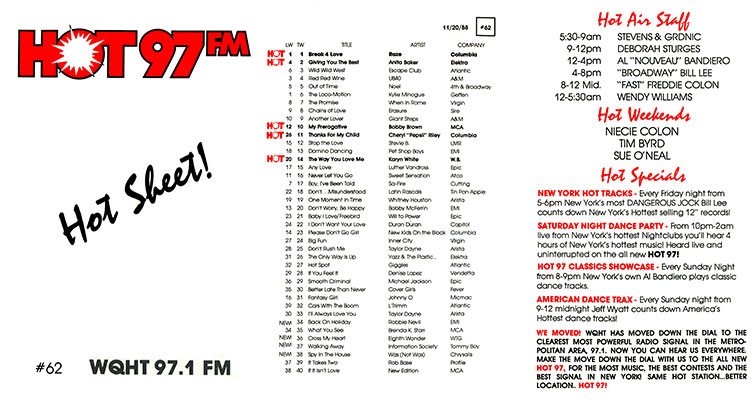
SURVEY: WQHT Hot 97 Year-End 1997
Contributed by Rich Barbato
The Phat 500 Countdown: A big list of hip hop. "Where Hip Hop Lives" - I wonder where they got that phrase from.
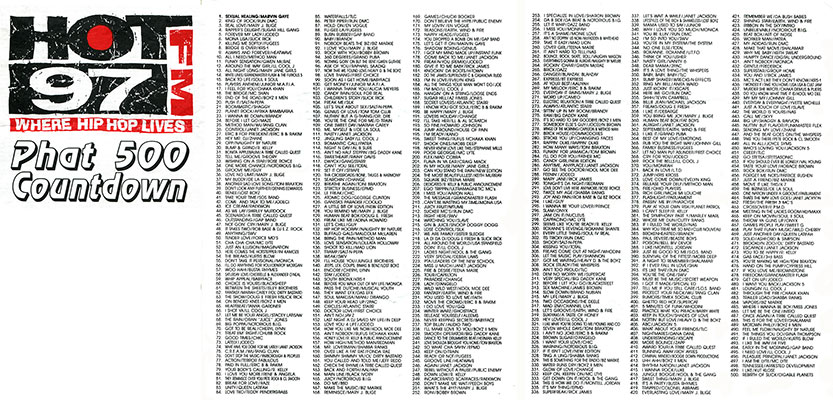
PROMO: Scott Muni
circa 1999
Promotion from Q104
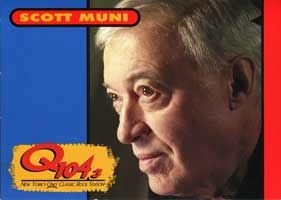
PRESS: Pete Fornatale Returns to WFUV
Billboard: March 24, 2001
A Billboard article announcing Pete Fornatale's return to WFUV, which happened a month earlier. Fornatale had the first rock show on New York FM radio, beginning in 1964 on that station before joining WNEW-FM.
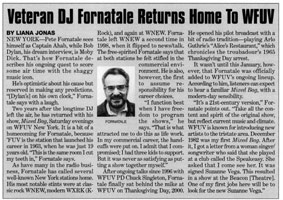
PROMOTION: Pete Fornatale Returns to WFUV
WFUV Program Guide: Spring, 2001
An article about Pete joining WFUV where Vin Scelsa and Dennis Elsas were already on the air. Pete had started his radio career at WFUV as a student, beginning in 1964.
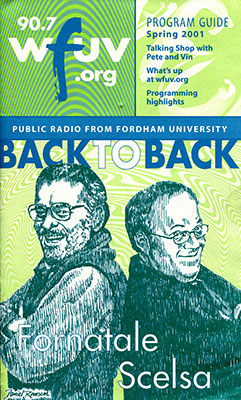
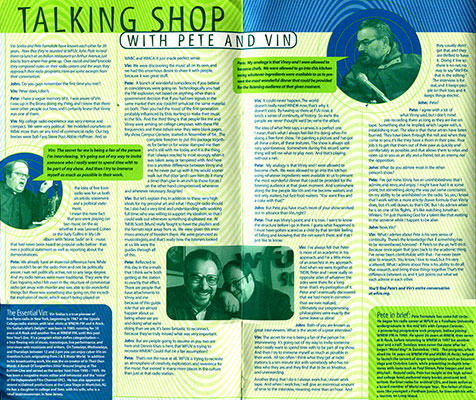
PRESS: The Last D.J.: Pete Fornatale
Long Island Press: July 7, 2005
An article about long-time New York DJ Pete Fornatale and his return to WFUV.
“The thing that happened at CBS FM was so offensive to me...”

PRESS: Bruce Morrow
NYU Alumni Magazine: Spring 2006
An article about the Cuz in the NYU Alumni magazine..
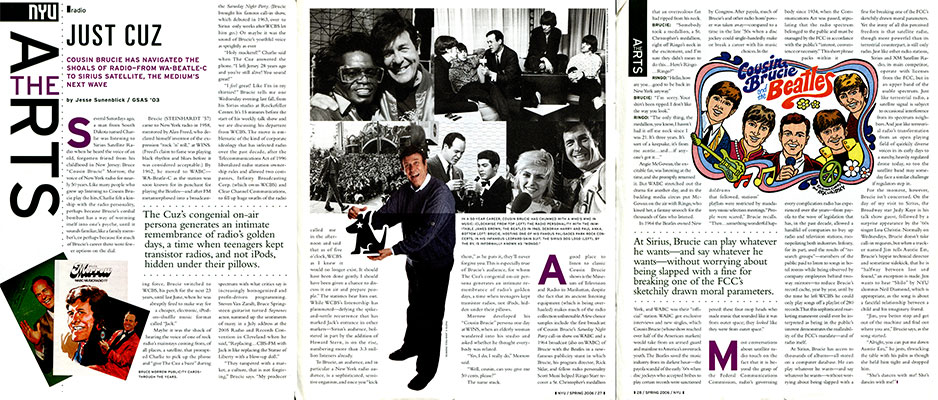
VIDEO: Pete Fornatale at Queensborough Community College
April 6, 2011 (59:54)
“The promoters of the Woodstock Festival originally offered the closing spot of the whole show to Roy Rogers”
Over the years, Pete prepared a number of audio/visual presentations, frequently to promote each of the many books he had written. This YouTube video is a presentation he made at Queensborough Community College. Although his presentation was largely about his Woodstock book, "Back to the Garden", this was different than his usual Woodstock audio-visual presentation.
Unfortunately, we only get to see some of the visuals. But we do get to hear Pete mention this site.
PRESS: New York Times: "Once A Ghoul, Always A Ghoul: John Zacherley"
October 21, 2012
“For someone who became famous for looking dead, John Zacherle, 94, looks pretty darn good.”
Here's a nice feature about Zach from the New York Times. While he's not a household name among Gen-X, Gen-Y or Millenials, I wouldn't say, as the article claims, that he lives in obscurity. He's still the leading draw at the Chiller Theatre conventions every year and he's fondly remembered by New York and Philadelphia area Baby Boomers as well as those who read "Famous Monsters of Filmland" magazine.
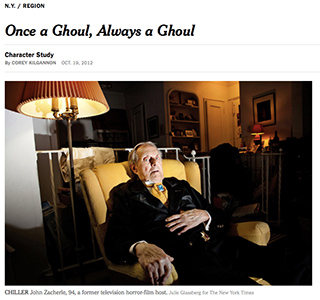
PRESS: New York Times: "Carol Miller: What Makes This D.J. Roll?"
March 25, 2013
“Listening to an automated system or preprogrammed music that's already been picked out for you by a computer is not the same as somebody playing something and telling you what's going on in sports, news, etcetera, as it's happening.”
Carol Miller has been on the radio forever and is still doing her thing. Even on programmed formats, she stil makes the show her own.
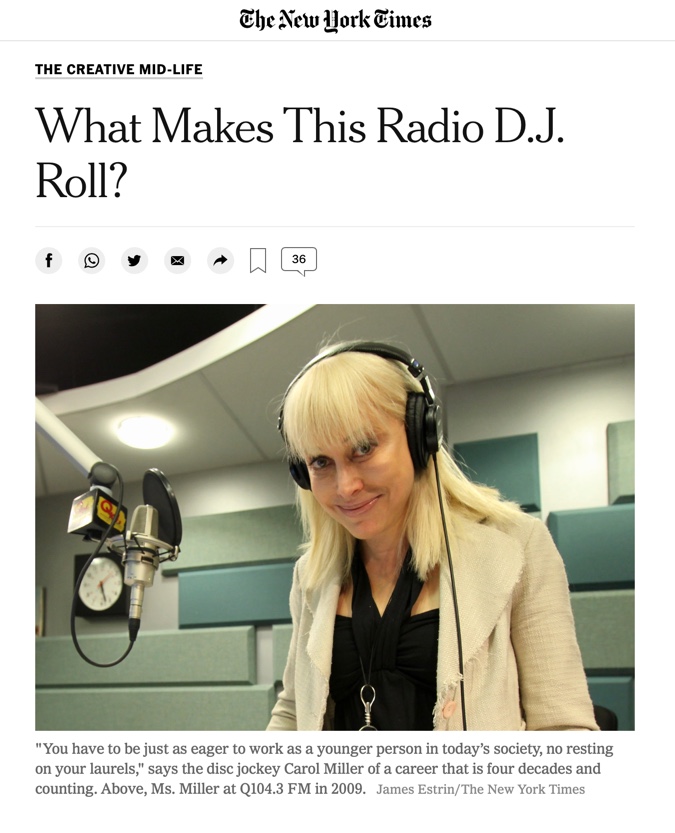
John Zacherley dies at 98
Thursday, October 27, 2016
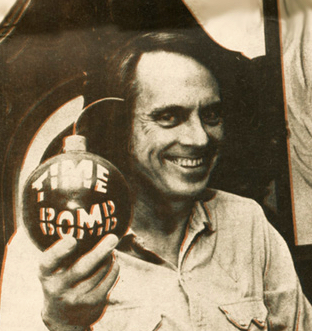
The great John Zacherley died Thursday, October 27, just a few weeks after turning 98 on September 26th and just a few days before the 49th anniversary of WNEW-FM and his favorite holiday, Halloween.
As a recording artist, low-budget movie actor, TV host (Chiller Theatre and Disc-O-Teen), book editor and rock DJ on WNEW-FM, WPLJ, WCBS-FM, WXRK and Sirius Satellite Radio, Zach has almost done it all. Zach even ran for President in 1960 (see the Metroplitan Review link below). About the only thing he hasn't done is to be a leading man, which he definitely could have been, which is proven by looking at older photos of Zach and his movie-star good looks.
In celebration of his recent birthday, Rhino Records posted a page and some tracks from Zach (but unfortunately, the link no longer works). You can find much about Zach on the WNEW-FM, WABC-FM, WCBS-FM and General History pages of this site.
Here's some photos we took of Zach with Pete Fornatale from February of 2006, when Zach was a remarkably spry 87:
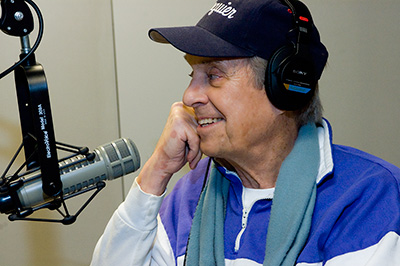
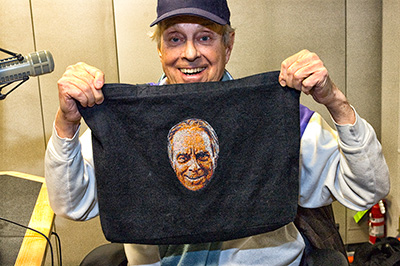
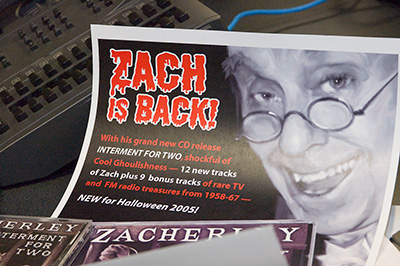
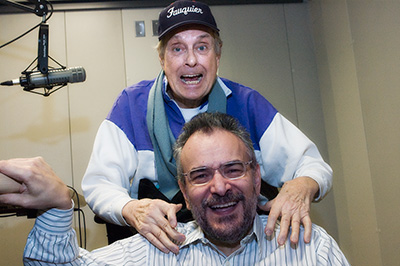

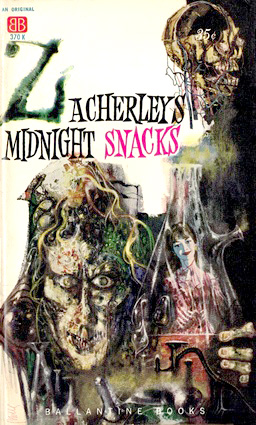
Here was the Rhino article (but the link is no longer active):

Here are some highlights of Zach throughout the site. There are additional small bits as well - check each page.
- Pete Fornatale interviewing John Zacherley on WFUV, October 15, 1966 AIRCHECK: Pete interviewing Zach for his "Campus Caravan" student radio show.
- John Zacherley on WNEW-FM, June 21, 1969 AIRCHECK: Zach sitting in for Rosko.
- John Zacherley on WNEW-FM, Fall, 1969 AIRCHECK: A short bit of Zach on a Summer or Fall '69 weekend.
- Pete Fornatale interviewing John Zacherley on WFUV, circa September 1970 AIRCHECK: Pete interviewing Zach for his "Campus Caravan" student radio show almost a year after he started working at WNEW-FM.
- John Zacherley on WNEW-FM, March, 1971 AIRCHECK: Zach really laid-back and loose.
- Metropolitan Review PRESS: Metropolitan Review covers Zach back in 1971, plus some earlier history of the man (and ghoul).
- John Zacherley on WPLJ, April 16, 1972 AIRCHECK: Zach hosting WPLJ's "Roots of Rock".
- John Zacherley on WPLJ, September 18, 1975 AIRCHECK: Zach doing his thing on WPLJ.
- John Zacherley on WNEW-FM, October, 1982 AIRCHECK: Zach returns to WNEW-FM for the 15th anniversary celebration.
- John Zacherley on WCBS-FM Oct. 31, 1984 AIRCHECK: Zach at Oldies CBS-FM from Halloween 1984 doing his "Cool Ghoul" thing.
- John Zacherley on WNEW-FM, October, 1987 AIRCHECK: Zach returns to WNEW-FM again for the 20th anniversary celebration (Zach is in part 1).
- John Zacherley on WCBS-FM Oct. 31, 1987 AIRCHECK: Zach at Oldies CBS-FM from Halloween 1987 and he sounds great.
- John Zacherley on WCBS-FM Oct. 31, 2001 AIRCHECK: Here's Zach sitting in once again on Halloween at CBS-FM in 2001.
- John Zacherley on Sirius Disorder Oct. 31, 2004 AIRCHECK: Sirius brilliantly asks Zach to sit in for a six-hour Halloween special show.
- John Zacherley on WCBS-FM Oct. 31, 2007 AIRCHECK: Here's Zach sitting in on Halloween once more at CBS-FM in 2007.
- NY Times PRESS: An article about Zach from 2012.
And here's Zach, sans makeup, from "What's My Line" in 1960:
Some years ago, a DVD was released called "The Zacherley Archives". It contained some kinescoped segments from his TV show. The quality is poor, but the bits are great and it begins with a contemporary interview with Zach. Here it is as posted on YouTube:
And here's one more: an interview author and journalist Dan McCue conducted with Zach in 2012.
PRESS: NY Times: John Zacherle Dies at 98
October 29, 2016
“Goodnight everyone, whatever you are.”
Here's the obit from the NY Times for the great John Zacherle, who died just a few days before Halloween and the 49th anniversary of WNEW-FM.
Zach had been around the Philadelphia and New York TV scene for years before joining WNEW-FM in December of 1968. Zach left for WPLJ in June of 1971, which became a highly formatted station shortly after he joined. He left WPLJ in 1980 and did occassional appearances and fill-in work on WXRK, WNEW-FM, WCBS-FM and Sirius satellite radio after that. And he appeared annually at Chiller Theatre conventions up until shortly before his death.
Perhaps more importantly, Zach was one of the nicest guys in the world. He was friendly and approachable everywhere he went. He will be sorely missed.
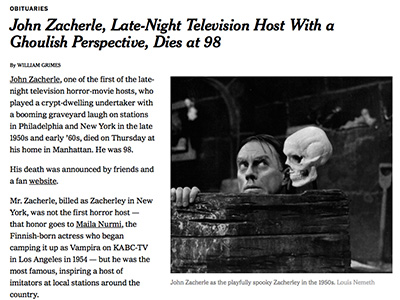
PRESS: The Fifth Beatle makes the NY Times Crossword
NY Times: April 16, 2019
“Noted 1950s-'70s D.J. dubbed a "fifth Beatle"”
I think it's quite amazing that at least 39 years after he was popular, this DJ makes the NY Times Crossword Puzzle. What air personality today will make the puzzle in the year 2058? None that I can think of. The correct answer, of course, is "MURRAYTHEK". But Murray may have taken offense that he was cited as being "a fifth Beatle" as opposed to "the fifth Beatle."
Of course, several other people have been defined as "the fifth Beatle" including Stu Sutcliffe, who actually was a fifth Beatle and played bass. He quit the Beatles to stay with photographer Astrid Kirchherr, the woman responsible for the Beatles' haircuts. He died in 1962 from a brain hemorrhage, possibly as the result of a fight he and John Lennon got into with some local toughs.
Beatles' producer George Martin was also sometimes referrred to as "the Fifth Beatle". It also sometimes referred to manager Brian Epstein, PR Manager Derek Taylor or Road Manager and later business executive Neil Aspinall. Keyboard player Billy Preston never officially joined the Beatles, but he was the only musical artist to ever receive label credit on a Beatles recording. And Eric Clapton also joined the Beatles on Harrison's "While My Guitar Gently Weeps".
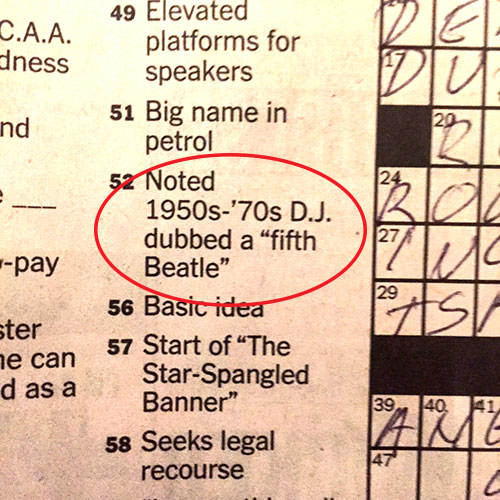
For more on Murray as the fifth Beatle, check this out elsewhere on this site: The Fifth Beatle
PRESS: Newsday: Rememmber when 'Super Soul' 16 WWRL Ruled the Radio World
Newsday: Friday, February 26, 2021
“We were the most copied Black radio station too [because] we identified with our listeners and our listeners identified with. us”
A comprehensive remberance of the great NYC AM station, WWRL 1600 including a quote from our friend, Rob Frankel.
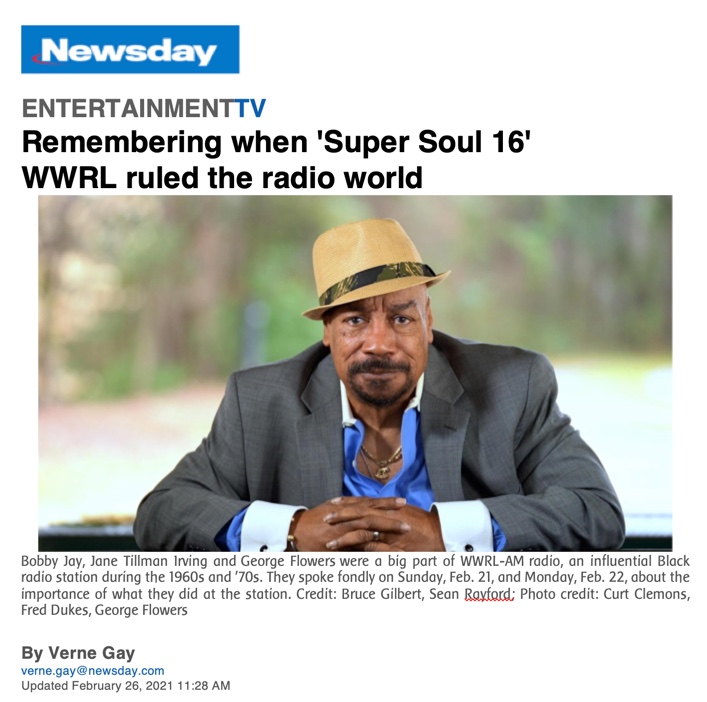
Click image for article
Click for original article with video
